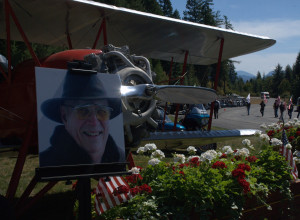A “celebration of life” was held today on Aug. 8 at the Bird Aviation Museum for its founder the inventor and aviator Dr. Forrest Morton Bird. Bird died in the early hours of Sunday, Aug.2, at the age of 94. A private burial was held for the WWII pilot and scientist earlier this week.
Approximately 400 people packed into one of the several hangars at the Bird Aviation Museum to watch a video documentary and slideshow, much of it narrated by Bird himself. In the video, Bird describes how his whole life has been a “challenge”. The packed crowd then went outside the hangar and watched a motorcade of motorcyclists and veterans rev their engines for the inventor described by many as “brilliant.”
Born on June 9, 1921 in Stoughton, Mass., the early years of the biomedical engineer Bird were spent aiding his father in his family’s machine shop. There he worked on many cars from the ‘20s and ‘30s. At the age of 8 Bird met Henry Ford at a local state fair. The two talked after Ford noticed Bird had converted one of his Model-As into a machine for shucking corn. Ford voiced his worry that using the Model-A as farm equipment would depreciate the automobile and people would be using it for tractor parts. Young Bird replied, “If you would just lower the price you’ll be okay,” recalled Bird Aviation Museum Foreman, Loren Spielman during Bird’s eulogy following the motorcade.
Probably most famous for his inventions in biomedical engineering, in 1955 he invented the Bird Universal Medical Respirator, also called the Bird Mark 7. The idea for the respirator came to Bird from his work in aviation and the breathing devices used for pilots when flying at high elevations. The equipment used in hospitals at the time for ventilation was, to many medical professionals, complex and difficult to maintain. His simplified version of the medical breathing devices changed the field of respirator medicine. “He is the father of mechanical ventilation, the father of respiratory care,“ said Dr. Felix Khusid, the director of respiratory care in New York.
In 1971, many years after his invention of the Bird Mark 7, he created the Babybird breathing device. The pediatric respirator is said to have saved thousands of premature babies born with underdeveloped lungs. The preemie lungs were too weak to handle the larger respirators and before the Babybirds were sometimes left blind as a result of the adult respirators.
Bird opened his aviation museum in 2007 in Sagle, Idaho. Many people were in attendance of the opening, including the crew of 60 Minutes who did a segment on the inventor and his fascinating life.
A winner of the Lifetime Scientific Achievement Award in 1985 and another in 2005, Bird was also honored by President George W. Bush in 2008 when he received the Presidential Citizens Medal. In 2009, President Barack Obama awarded Bird the National Medal of Technology and Innovation.
Bird began his formal education at a rural schoolhouse that taught five grades. Before entering straight into the second grade, he was tutored by his mother. Early recognition for his educational aptitude allowed him to skip both the third grade and the fifth grade. By the age of 14 he had become a pilot and flew for the military in WWII. Bird held doctoral degrees in both science in aeronautics and medicine.
Upon hearing of Bird’s death, co-found of Apple Steve Wozniak sent the Bird family a message. “Forrest Bird was such a happy person … the journey was clearly the reward for Forrest.”
Many spoke of how Bird left this world a better place than when he entered. Many also recognized his positive impact on the North Idaho community and in the area of youth education. A charter school in Sandpoint changed its name to Forrest M. Bird Charter School 2010 in order to make sure Bird was fully sealed into Idaho history. When Forrest first heard about the plan to name a school after him his response was both of shock and humility, “Why do they want to name a school after me? Don’t they know they name schools after dead people?” Mary Jensen recalled during her speech at the celebration.
Eventually he gave in and allowed the school to use his moniker. Jensen also talked of Bird’s work with Idaho youth during his multiple school visits and presentations and said children were inspired by him. “He gave our kids inspiration to know they can do anything, “ Jensen said.
Jensen also shared a story of a youth named Patrick who recently graduated from the Sandpoint charter and how the youth’s life was saved by the Babybird respirator. Unable to attend the recent graduation at the charter school named after him, the youth’s family sent a message to Bird, “Patrick would not have been here today if it was not for him. He was born with great disabilities. They had no idea after he was saved, put in the Babybird and was sent home that he was going to graduate from Forrest M. Bird Charter School. He was there at the beginning of their child’s childhood and the beginning of his adulthood. There is nothing they could ever do to repay their thanks to him.”
Bird aviation director and step daughter of Bird, Rachel Schwam, said that the museum would continue to do Bird’s work in both education and innovation.
The final speech during the celebration was made by Bird’s widow Dr. Pamela Bird. She talked about the genius and humility of Bird and of the great amount of loss at her husband’s passing. “Old pilots don’t die, they get a new set of wings.”
At the end of the ceremony, Bird’s granddaughter released 94 red balloons into the blue skies above the green forests surrounding the Bird Aviation Museum.
For more information about Bird or the museum visit: www.birdaviationmuseum.com

